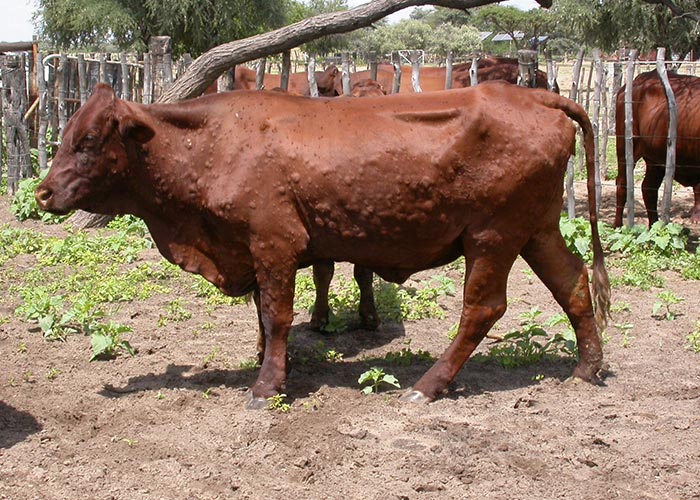4 deadly livestock diseases and how to control them

To avoid health problems in cattle routine health care procedures should be followed. It is important to recognize the dairy cattle herd in general and then the individual cows in particular for any health issues.
This can be done through attentive observation, touching individual cows, smelling and even by hearing sounds from cows. These are important points to identify health problems in the herd and to take appropriate action on time. This article will help you identify some of the most common yet fatal diseases and how to control and prevent them.
1. Lumpy Skin Disease
Lumpy skin disease is a highly infectious viral disease characterized by pox like intracutaneous firm nodules, edema of the limbs, superficial lymph nodes swelling, and lymphangitis.
Symptoms include painful swelling, fever, lacrimation nasal discharge and hyper salvation followed by characteristic eruption on the skin and other parts of the body, swollen lymph nodes,secondary infection leading to suppuration and sloughing.
Prevention and control measures include vaccination and supportive treatment against secondary infection.
2. Foot and Mouth Disease
Foot and Mouth Disease is a highly communicable viral infection characterized by fever, vesicles in the mouth, on the muzzle, gums, pharynx, teat and interdigital cleft. It is transmitted by contact and through milk. Recovered animals remain carriers for up to 2 and half years.
Symptoms includes drooling and vesicle on the nares, in the buccal cavity and between the claws are the most common. Dullness, in appetence, fever, shaking and kicking of the feet, abortion of pregnant animal, death of calves are also clinical signs.
Prevention and control measures includes vaccination, test and quarantine and supportive treatment.
3. Anthrax
Anthrax is a per acute, acute or sub acute soil borne bacterial disease affecting mammals. It is characterized by exudation of dark tarry blood from natural orifices. It is fatal zoonotic disease affecting humans and animals resulting in huge economic loss. The bacteria can survive for long period of time by undergoing sporulation and be source of infection.
In per acute case animals die suddenly without showing any signs. There is high fever tremors, depression, convulsion, respiratory distress, abdominal oedema, bloody milk, rumen atony, abortion is observed in acute and sub-acute cases.
Anthrax does typically not spread from animal to animal nor from person to person. The bacteria produce spores on contact with oxygen. These spores are extremely resistant and survive for years in soil, or on wool or hair of infected animals. Then if ingested or inhaled by an animal, or on entering through cuts in the skin, they can germinate and cause disease.
Because the blood of infected animals sometimes fails to clot and may leak from body orifices, insects can spread the bacteria to other animals. Typically animals become infected by ingesting spores which are in the soil or in feed.
Prevention and control measures include:
- Undertaking regular vaccination programs based on the Anthrax season in the area
- Proper disposal of dead animals is critical; – the carcass should not be opened, since exposure to oxygen will allow the bacteria to form spores
- Premises are to be quarantined until all susceptible animals are vaccinated and all
- Carcasses disposed of preferably by incineration or alternatively by deep burial with quick lime.
- Cleaning and disinfection are important as is control of insects and rodents.
- Treatment of sick animal with appropriate antibiotics;
4. Trichomoniasis
Trichomoniasis is a venereal disease of cattle that causes early embryonic death, prolonged breeding, occasional abortions and infertility. It is caused by a small motile protozoan found only in the reproductive tract of the bull and cow. It is transferred to the cow’s vagina from the bull during breeding migrate up to the uterus and cause the infection.
The key clinical signs are low conception rate, profuse discharge from the vulva, early abortion (2-4 months of pregnancy), pyometra- accumulation of pus in the uterus.
No vaccines are available for its prevention, but using artificial insemination and virgin bulls aid in control. Bulls are the main carriers of Trichomoniasis and, once infected, remain infected for life but show no signs of disease.
Infected animals should be culled.
5. Blackleg
It is also a soil born bacterial disease mostly affecting animals with 2-4 years of age. It affects animals in good body condition especially with good nutrition management. Infection occurs through contamination of the environment from infected faeces and decomposition of carcass. The same to anthrax, it undergoes sporulation in the soil and serve as source of infection for long period of time.
Symptoms include:
- Welling of one the limbs commonly around the shoulder on heavy muscle.
- Characteristic oedematous and crepitating sound on palpation of affected areas in the hip, shoulder, chest, back, neck, or elsewhere
- Febrile, inappetance, rough coat, depression, lameness, etc can be observed.
Prevention and control measures include:
- Regular vaccination
- Treatment of sick animals with appropriate antibiotics
Thanks for the details.